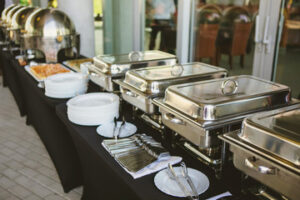Foodservice and Catering Essentials
Whether it’s a daily lunch, dessert break or late afternoon refuel, catering shows employees that their employer cares. It also saves time because meetings and training sessions can continue while everyone eats. 
Companies usually order individual orders from restaurants or use a catering company to provide platters and set up buffet-style for larger groups. Some restaurants offer a ready-to-eat menu option for smaller groups as well. Contact Dos Reyes PGH for specialized services.
Foodservice operators often struggle with the balancing act of maintaining the right menu variety and minimizing or eliminating food waste. A successful menu planning process will involve an analysis of the restaurant concept and a careful consideration of its potential impact on other aspects of the operation, such as dining capacity, kitchen efficiency, supplier pricing, seasonal availability and even consumer demand.
The ability to anticipate future trends and prepare for them is another major benefit of effective menu planning. For example, if an operator intends to add a new, must-have trending dish to its offering, it can ensure that the equipment needed to prepare it is in place and that its cooks are well trained. This protects the restaurant from disappointing customers who inquire about a dish only to receive the unpleasant news that it’s unavailable.
Another key aspect of menu planning is maximizing the use of ingredients. A single item, such as a chicken breast, can be served in multiple ways if it’s carefully planned. For instance, it might be used in teriyaki chicken, home-style chicken noodle soup, Napa almond chicken salad and buffalo chicken pizza. This prevents the need to stock up on multiple items and saves money by reducing storage space and inventory costs.
Lastly, the process of menu planning helps restaurants to avoid making mistakes while stocking up on supplies. Without a good plan, it’s easy to over-order and then discover that your kitchen and dining capacity isn’t capable of selling the entire supply. In this case, the food would eventually go to waste.
The other issue that can arise is the temptation to introduce too many new dishes at once. It’s important to remember that consumers can be overwhelmed by too much choice, and a restaurant’s reputation may suffer as a result of this over-expansion. A good menu plan will include a set of guidelines and limits, which can help to avoid these issues.
Food and Beverage Options
As the industry continues to evolve, understanding food and beverage (F&B) is crucial for hospitality professionals. It’s the backbone of every restaurant and catering operation, influencing customer satisfaction and establishing brands as unique and memorable.
Developing a drink menu that pairs with your food items is a great way to boost revenue and add value to the guest experience. A carefully curated beverage selection also appeals to a broader audience by including options that suit dietary needs and preferences.
Non-alcoholic beverages are an essential offering in any restaurant, cafe, or commissary kitchen. Fresh juices, which can be complemented with protein or superfoods, are a nutritious choice that attracts health-conscious customers. Other popular drink options include iced teas, coffees, and soda alternatives that are low in sugar but still taste delicious. Providing multiple beverage options allows you to accommodate a diverse range of customers while keeping your overall budget in check.
Plating
Plating is an exacting but fun skill to master. It can elevate the overall experience of your food, stimulating the appetite, while creating balance and a sense of harmony between the elements on the plate. It also helps to avoid tasting boredom by ensuring that contrasting textures and flavors enliven each bite.
Whether you are working with savory (Culinary Arts) or sweet (Baking & Pastry Arts), plating is an opportunity to express your personality and creativity. You can integrate the theme of your event, highlight specific ingredients, or incorporate interactive elements for an extra-special touch.
A good plating technique will make the difference between a diner enjoying your meal or walking away feeling unsatisfied. Several factors go into making a dish look and taste great, including balance/proportion, height, negative space, and color/texture. To create the right effect, the main component should take center stage with supporting elements arranged around it. It is important to use the right temperature, and to pay attention to garnishes, which should add flavor and visual interest but not overwhelm the dish.
Metal plating is the process of coating materials with a thin layer of metal. This is done to improve aesthetics, protect them from corrosion, or to meet functional needs such as solderability, strength, lubricity, and conductivity. The type of metal used for plating depends on the application; silver is a popular choice for electrical applications due to its high conductivity and low power-conductance threshold.
The cost of the plating process can depend on the type of metal used, and the complexity of the work required. For example, a highly complex and precise selective plating process might involve specialized equipment and increased labor costs. It is important to evaluate all the factors involved in a particular plating project and determine the best course of action to minimize costs. To do this, you will need to develop a cost estimate that considers all the relevant variables. Using a spreadsheet can help you calculate the total cost of each plating option. Then, you can select the most cost-effective option that meets your requirements and budget.
Flexibility
Flexibility is the ability of muscles and joints to move through a full range of motion without restrictions. Flexibility helps prevent injuries, promotes proper body alignment and movement efficiency and may decrease as people age. Flexibility testing typically involves using a device called a goniometer, which consists of a base that looks like a protractor and two thin extensions that can stretch or contract to measure the angle at the joint.
Flexibility in business means embracing change instead of fighting it. It can help you adjust your budget as market conditions change, keep your marketing channels up to date with the latest technology and keep your team energized during periods of intense growth. It can even help you stay open to new opportunities and expansions.
For example, if you find yourself running into more success than expected with one of your paid advertising channels, flexible budgeting allows you to reinvest more of the money back into that channel and generate more revenue. This is a win for you and your employees, and it’s also a win for your customers.
Another way that flexibility can benefit your business is by making it easier to attract top talent. Providing your hospitality industry team members with the flexibility to choose their schedules and work from home options is an attractive feature for candidates looking to balance their careers and family lives. A transparent and well-communicated flexible working policy can help you recruit, hire and retain the most qualified staff for years to come.
In addition to flexible budgeting, a contingency plan is an essential tool for businesses that want to protect themselves from financial disasters. Contingency plans are like a safety net that allows you to cover unexpected expenses or revenue dips without breaking the bank. They’re especially important if you operate in an unpredictable market where market fluctuations are common. The best part is that they’re not difficult to prepare, so you can start planning for the worst before it happens. Creating a contingency plan requires understanding the risks of each type of budget and evaluating your business’s current situation and future goals.






